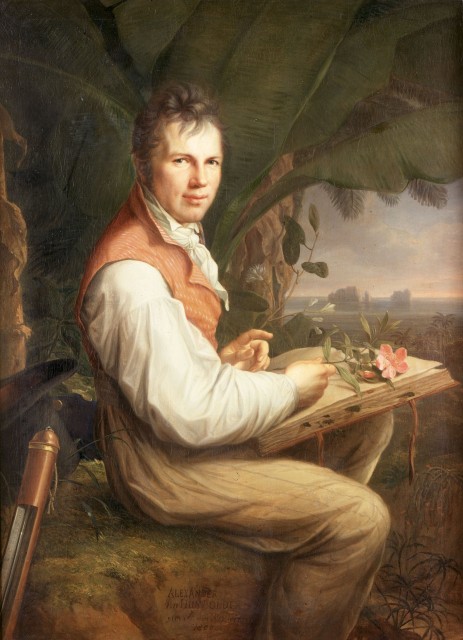Humboldt, Alexander von (1769–1859)
ALEXANDER VON HUMBOLDT is significant to the study of geography because of the breadth of his scientific inquiries and knowledge and his ability to integrate these studies within larger works that were both scientifically advanced and appealing to a wider nonspecialist public. He was known as a natural scientist of the highest order, working to unify studies of botany, zoology and ecology, but also as a competent writer, whose works provided a wide audience with their only glimpse of South America, a continent previously known to most through myth and speculation.
Born into a relatively minor noble Prussian family, he was equally a product of his class and of his times. Young men of wealth and breeding in mid-18th-century Berlin were influenced by the philosophies and scientific principles of reason inherent in the French Enlightenment, as well as the more adventurous spirit of early German Romanticism. Accordingly, Humboldt went to the leading universities of the day, especially Gottingen, to immerse himself in the natural sciences. A natural polymath, he undertook courses in botany, literature, archaeology, electricity, mineralogy, and so forth.

After a short career working for the state as a mineralogist, he did what so many of his generation and social class did and set out for his grand tour. But Humboldt did not head to ITALY or GREECE as was fashionable. Instead, he set his sights on South America, which at that time was mostly unknown and in fact restricted to non-Spaniards. But the king of SPAIN was attracted to the fact that Humboldt had his own means to support his travels and to his potential as a mineralogist, since the silver mines of Peru were not infinite.
Humboldt spent five years traveling with his companion Aime Bonpland across VENEZUELA, COLOMBIA, ECUADOR, PERU, MEXICO, and CUBA, returning in 1804 to Paris, FRANCE, where he began to publish accounts of his travels. His descriptions captured the imaginations of both scientists and the general public, with its details of canoe trips up the Orinoco River and horseback rides across passes high in the ANDES, and also with vivid illustrations done by Humboldt himself. Scientifically, his work was useful not simply as a collection of botanic and zoological specimens, but also as a work of analysis on the forces of nature and on how the geographic environment influences plant and animal life of a certain region.
This was an innovation in a scientific community generally more interested in description and classification than in interpretation. Humboldt's writings stress again and again the importance of unity in nature and man's understanding of environmental systems in their entirety. His monographs on Mexico and Cuba set a standard for the field of geography, being the first to incorporate natural science, politics, and economics all within one study.
By the 1820s, Humboldt was arguably the most famous natural scientist in the world. He was well known in all scientific quarters but was also personal friends with the leading Romantics, such as Johann Wolfgang von Goethe. His prose was admired not just as brilliant science, but as beautiful literature. His major work, Relation historique du voyage aux regions equinoxiales du nouveau continent, was published eventually in 30 volumes, appearing intermittently between 1814 and 1834. One of these volumes was called Personal Narrative, and it included Humboldt's thoughts on his own place within the world he was studying. Later travels included a voyage to RUSSIA and Central Asia in 1829, with an account published in 1843. His third major work was a comprehensive survey of all creation, Kosmos, published posthumously in 1862.
Humboldt was part of a long traition of polymath scholars or Renaissance men, whose specializations reached into numerous disciplines and subfields, bringing comparative knowledge to its greatest advantage in whatever arena he explored. And like many of those before him, Humboldt was not merely content to be a scientist. He remained loyal to the calling of his noble origins, serving many years at the court of the Prussian kings in Berlin, first as chamberlain to Friedrich Wilhelm III, then as councilor of state to Friedrich Wilhelm IV. His works served as inspirations for the next generation of scientists, most notably Charles Darwin, who knew parts of Narrative by heart.